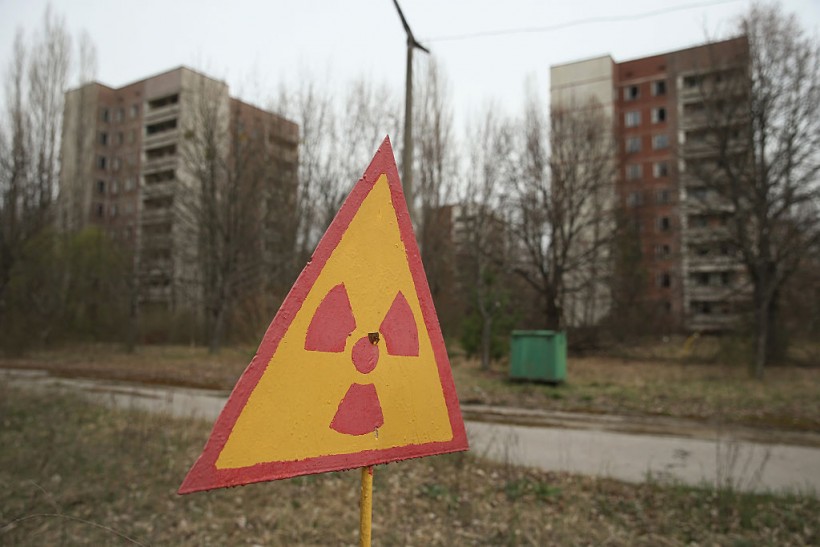Radiation is a component of everyday life for many people. Even stepping outside exposes you to minor doses of ionizing radiation from the sun. Certain foods require 'exposure' to radiation to be consumed (albeit in tiny quantities).
However, you should definitely thank your lucky stars that you don't live near any of the world's most radioactive locations.

PRIPYAT, UKRAINE - APRIL 09: A sign warns of radiation contamination near former apartment buildings on April 9, 2016 in Pripyat, Ukraine. Pripyat, built in the 1970s as a model Soviet city to house the workers and families of the Chernobyl nuclear power plant, now stands abandoned inside the Chernobyl Exclusion Zone, a restricted zone contaminated by radiation from the 1986 meltdown of reactor number four at the nearby Chernobyl plant in the world's worst civilian nuclear accident that spewed radiaoactive fallout across the globe. Authorities evacuated approximately 43,000 people from Pripyat in the days following the disaster and the city, with its high-rise apartment buildings, hospital, shops, schools, restaurants, cultural center and sports facilities, has remained a ghost-town ever since. The world will soon commemorate the 30th anniversary of the April 26, 1986 Chernobyl disaster. Today tour operators bring tourists in small groups to explore certain portions of the exclusion zone.
Four Most Radioactive Places in the World
So, without further ado, here are some of the most radioactive locations on the planet. The following list is not complete and is not in any specific order.
1. Japan - Fukushima Daini Nuclear Power Plant
A 9.1 magnitude earthquake caused a tsunami in Japan last 2011, Britannica said. It overcame the Fukushima Daini Nuclear Power Plant's current safety mechanisms, resulting in the biggest nuclear power plant accident since Chernobyl.
Although the facility survived the initial earthquake, the wave that followed was more than twice as powerful as the plant was built to withstand. The saltwater pumps at the facility, which were supposed to keep the reactors cool during the outage, failed due to this occurrence.
As a result, the plant's three reactors began to leak radioactive material and polluted wastewater spillovers, which all ended up in the Pacific Ocean.
While the nuclear reactor was shut down totally, enormous volumes of radioactive waste were nevertheless released into the environment. Nei Magazine said experts expected to decommission the power station in more than four decades.
2. Ukraine - Chernobyl Power Plant
The Travel said the world was horrified by one of the deadliest and most well-known catastrophic nuclear power plant accidents in April 1986. The incident happened during a late-night safety test at the facility, intended to mimic a power failure at the station.
The plant's genuine safety mechanisms were deactivated, resulting in a major steam explosion and an open-air graphite fire. The fire shot radioactive plumes high into the stratosphere, causing deadly fallout over the Soviet Union and parts of Europe.
The World Health Organization said over five million individuals in the former Soviet Union were believed to have been exposed to radiation. This group has had higher-than-normal rates of cancer and other ailments, on top of the high mortality rates among those assigned with cleaning up the site. The area immediately surrounding the old factory is still one of the world's most radioactive locations.
ALSO READ: Restricted Radioactive Material Used in Making 'Dirty Bomb' Stolen from Chernobyl Site
3. Washington, USA - Hanford Site
Another location on the list is the Hanford Site in Washington, USA. It was the United States' principal Plutonium manufacturing plant for its nuclear weapons stockpile during the Cold War.
Reports said plutonium was synthesized here for about 60,000 nuclear bombs, including the batch used in the 1945 "Fat Man" bomb fired on Nagasaki. It is now handled by the US Department of Energy. Despite being deactivated, it contains over 60% of the high-level radioactive waste (by volume).
Although the bulk of the manufacturing waste was buried below, extensive amounts of groundwater were poisoned as a result.
4. Somali Coast
For years, it has been believed that an Italian mafia has been illegally dumping nuclear waste and other dangerous chemicals in the unprotected soils and waterways off the Somalian coast.
Nature estimated that 600 barrels of hazardous and radioactive garbage and hospital waste containing nuclear elements were deposited here. The area may be on the verge of becoming a future environmental disaster.
The UN Environment Program thinks that the rusty garbage barrels that washed up on the Somalian coast following the tsunami of 2004 were deposited in the 1990s.
RELATED ARTICLE: Chernobyl Vs. Zaporizhzhia Nuclear Plants: Why the Latter is Safer and Doesn't Spread Too Much Radiation?
Check out more news and information on Energy in Science Times.














